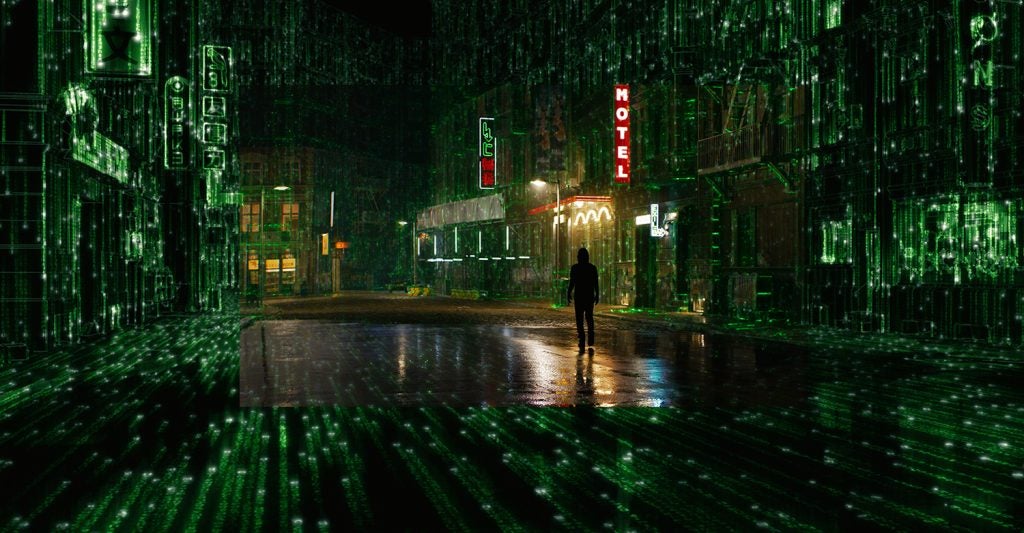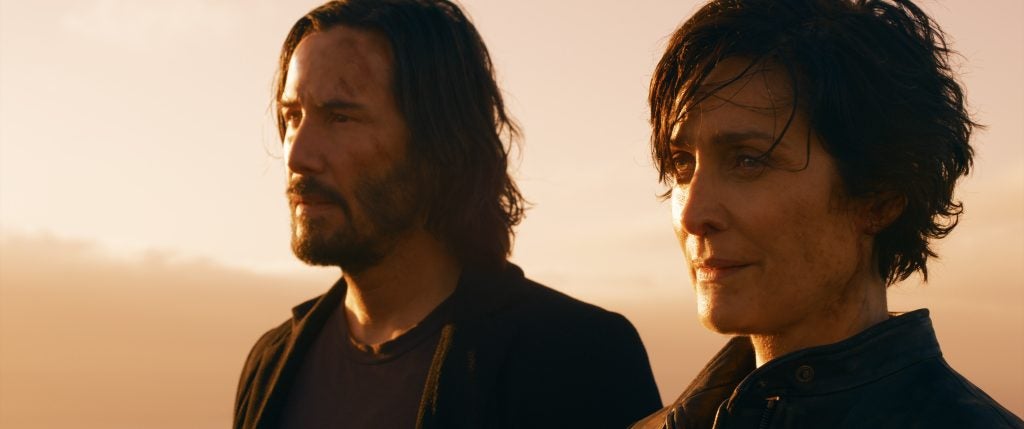For years now, we’ve been living in a prequel/origin-story world in which seemingly every third movie is constructed to tell us how some iconic character we’ve known and loved got to be the way they are. Whether it’s the Star Wars prequels or Cruella, Hollywood wants to fill in the blanks of its most popular narratives while taking more of our money. The way the studios figure it, we’re so endlessly fascinated by these famous fictional figures we’ll gladly buy a ticket to hang out with them yet again.
This is a tiring trend, of course, but I can think of one that’s even more aggravating, and it hamstrings The Matrix Resurrections, the heavily anticipated new film from Lana Wachowski, who returns to the universe she and her sister Lilly concocted back in 1999. It’s been nearly two decades since we’ve had a Matrix film, but while this sequel is occasionally emotional and boasts a few impressive action sequences, what endlessly frustrated me was Wachowski’s approach. Like a lot of people, I fell for The Matrix because of its stunning conception of our reality — how it pictured us all as being held captive in a simulation concocted by robots who were now our overlords. It was a metaphorically rich idea — one that has defined and haunted society ever since — but that’s not exactly what Wachowski pursues in The Matrix Resurrections. She’s more interested in exploring the actual world that she and Lilly first hinted at in the first film. If you’ve been craving a movie that explains the architecture of how the Matrix works, then Resurrections will make your day.
Worldbuilding is a pretty common trope in movies, although it goes back to fantasy writers like J.R.R. Tolkien, who didn’t just craft characters and plots but also elaborately envisioned the universes where the action takes place. Worldbuilding broadens the canvas, enlarges our understanding of all the events taking place in a franchise. Every Star Wars movie travels to new planets, while John Wick delves deeper into the underground society of hitmen in each subsequent sequel. It can be fun to see how these ecosystems operate.
But there’s a fine line between expanding a film’s setting and overexplaining how the whole damn thing works. I often think about Patton Oswalt’s 2007 standup bit “At Midnight I Will Kill George Lucas With a Shovel,” in which he fantasized about stopping Lucas from making the prequels, yelling at one point, “I don’t give a shit where the stuff I love comes from! I just love the stuff I love!” He was talking about the endless backstory-ification of modern blockbusters, which shows no signs of receding anytime soon, but I think it should also apply to the obsessive worldbuilding that can sometimes occur within these properties. As much as I enjoy the John Wick sequels, my eyes start to glaze over when the filmmakers take time to lay out the intricacies of the different factions within his assassin community. I mostly just want to see the guy kill people.
Keanu Reeves’ other big franchise also had this problem. Starting with The Matrix Reloaded, Lana and Lilly Wachowski dealt with the enviable problem of how to expand what they created in The Matrix, fleshing out the logistics of what went on inside the Matrix and inventing new characters who roamed around within that environment. There was a guy with a bunch of keys. There was a snotty French dude. Monica Bellucci showed up. But both The Matrix Reloaded and The Matrix Revolutions could be slogs because the worldbuilding got in the way of the excitement and shock of that first film, which had cleanly established enough of the hows and whys of the Matrix so that we could follow along without needing a roadmap.
Unfortunately, the sequels were where the Wachowskis were stuck crafting the roadmap, and now with The Matrix Resurrections, Lana continues to explain things — especially because it’s been quite some time since Neo (Reeves) was fighting the evil robots. As we’ll discover, shit’s changed since then, but unlike the elegant, brisk exposition of The Matrix, the new film feels like one of those video games in which you meet characters, who then dump a bunch of plot information on you before sending you on your way to meet another character, who will invariably do the same. There’s some clever ideas in Resurrections, and a bittersweet romance that’s dying to take center stage, but more often than not we’re bludgeoned with worldbuilding.

Let me dispense with the plot quickly: We meet Thomas Anderson (Reeves), a video game mogul who’s been approached to do another installment in a trilogy he swore he’d never revisit. But the studio is insistent, and he gives in. By the way, the studio is Warner Bros., and the property is something called The Matrix — clearly a bit of inside-baseball that allows Wachowski to mock the studio heads that have been trying to browbeat her into making another Matrix movie for years. Eventually, though, Anderson’s world is thrown for a loop: A man named Morpheus (Yahya Abdul-Mateen II) comes to visit him, and soon Anderson remembers he’s Neo and must do battle with the evil robots once again.
Why is Morpheus played by a new actor? What happened to Agent Smith (Hugo Weaving)? Where is Trinity (Carrie-Anne Moss) inside the Matrix? And, wait, didn’t she and Neo actually die at the end of The Matrix Revolutions? There’s a lot to unpack in The Matrix Resurrections, but although Wachowski has said that the film was a way for her to process the death of her parents, using Neo and Trinity’s enduring love story as a sort of psychic balm, that emotional core keeps getting lost in the busywork of worldbuilding. This is happening because of this. Since the last movie, this thing has changed and now works this way. That actor is now portraying this memorable character because of this reason. Neo needs to do this thing to make that thing happen, and so he needs to go over there and take care of this other thing.
As someone who’s had to keep up with the often-tedious connections between different movies in the Marvel Cinematic Universe, I’m more than familiar with the demands that modern blockbusters place on the viewer: We don’t just have to watch these adventures play out, we have to retain information about side characters, subplots and other digressions. But The Matrix Resurrections’ emphasis on what exactly the hell is going on takes away from what made The Matrix so singular. The world the Wachowskis dreamed up in that movie felt intricate but operated pretty simply — we’re in a simulation, and once you realize that, you can control it in cool ways — and so you didn’t have to think about it too deeply. You could just enjoy the mind-bending effects and the vaguely revolutionary notion of rising up against the oppressors keeping us down — easy-peasy.
Unfortunately, the effortlessness of the Wachowskis’ original design is largely missing in The Matrix Resurrections, replaced by explanation, exposition and new environments that don’t have the same inspiration as what came before. (You never entirely shake the feeling that Lana is making it up as she goes along.) As a result, Neo mostly wanders from location to location, acquiring new information and then moving on to the next spot. What’s missing are the fun little ideas Lana and Lilly devised for the 1999 film. You know how we all experience déjà vu? Well, The Matrix had an ingenuous theory for what’s really going on in that moment — it took seconds to explain and made perfect sense. If that had happened in Resurrections, it would require three characters talking back and forth about it endlessly.

All of this is a shame because, on occasion, the new movie recaptures the original’s anarchic fun. And there’s a palpable sadness in having Neo and Trinity not recognize one another, a hint of how whatever has occurred to the Matrix since Revolutions has also affected them. But even that plot twist feels labored and over-explained — which only illustrates how much better two 2021 arthouse films did with the same conceit of having lovers lose their ability to see each other, Preparations to Be Together for an Unknown Period of Time and What Do We See When We Look at the Sky? Sure, those titles are long, but at least those movies don’t spend the entirety of their runtime going over how things operate in their world and why the characters need to do certain things so that other things can happen. Too much of Resurrections feels like homework, one of those math word problems that make you go cross-eyed.
In our age of nonstop franchises, Hollywood seeks to get us hooked on the minutiae, stringing us along so that we feel a sense of ownership of not just the characters but their entire universe. But a movie like The Matrix Resurrections underlines the downside of that strategy. Ironically, all I wanted was to spend more time with the characters, to be back on the ride with Neo, the seemingly ordinary man who is destined to be the one that will save humanity. But in the new film, he’s just part of the furniture, another thing I’m supposed to keep track of. Every creative impulse is subsumed in the need to justify the sequel’s very existence.
When the Wachowskis came up with the idea of the Matrix, they invited audiences to project their own anxieties about modern life, technology and the loss of individualism into their fabulous design. It was a resonant idea and it took on a life of its own, its power coming from the fact that we could very easily fill in the blanks ourselves — it was something we created alongside them. Twenty-two years later, Lana is fixated on the nuts and bolts of that world, but she doesn’t leave space for our imagination. It’s a machine that has no room for dreams or wonder.

